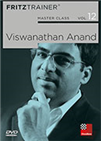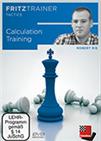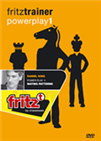Carlsen, Svidler and Gelfand in the lead
Magnus Carlsen met his predecessor as world champion Viwanathan Anand in the second round of the “chess24 Legends of Chess” tournament. In 2013, Carlsen dethroned Anand, and in 2014 Carlsen won his first title defence by again defeating Anand, who had stunned the chess world by winning the Candidates Tournament in Khanty-Mansiysk.
 This DVD allows you to learn from the example of one of the best players in the history of chess and from the explanations of the authors how to successfully organise your games strategically, and how to keep your opponent permanently under pressure.
This DVD allows you to learn from the example of one of the best players in the history of chess and from the explanations of the authors how to successfully organise your games strategically, and how to keep your opponent permanently under pressure.This time around, Carlsen had a difficult time but in the end again managed to defeat the Indian. He only did it after Anand faltered in game 4. As reported by Tarjei J. Svensen, Carlsen told the Norwegian press:
It was a win I had to struggle to get, contrary to the one against Giri yesterday. [...] It was a difficult day. I had the chance in the first game, and after that it wasn’t easy.
Nevertheless, this was Carlsen’s second consecutive win, and both times he defeated his opponent without needing to play an Armageddon decider. He is not the only player that had a perfect start though, as Boris Gelfand and Peter Svidler also have 6 points after two rounds (a win without Armageddon grants 3 points, while if the win is obtained in the tiebreaker the winner gets 2 points and the loser gets 1 point).

Click to enlarge
Carlsen 2½ : 1½ Anand
Anand is twenty years older than his successor, and last year he celebrated his 50th birthday. But even at this age he has kept his place among the very best in the business. In his mini-match against Carlsen yesterday, the first three games ended in a draw. Anand kept the fourth game balanced for a long time, but then he let it slip out of his hands.
24.Nf5 Losing a pawn. [24.a3 Nf4 25.Nf5 with an equal game.] 24...Bxa2+ 25.Kxa2 Qa5+ 26.Kb1 Qxd2 27.h4 Rf7 28.h5 Nf4 29.g5 Perhaps planning to checkmate black after opening the h-file with g6. 29...a5 [29...b5 would prevent Nc4.]
30.Ne3 [30.g6 hxg6 31.hxg6 Rf8 32.Qg5 with counterplay.] 30...Qb4 31.Nc4 a4 32.g6 hxg6 33.hxg6 Rf6 34.Rh8+? Weakening White’s back rank. [34.Qg5 Ne6 35.Qxe5 b5 36.Ne3 Rxg6 37.Nf5 and the game is not over yet.] 34...Ka7 35.Qg4
35...Nxg6 [35...Qe1+ 36.Ka2 Nxd3 37.cxd3 Rf1 38.Ka3 c5 already leads to a forced mate.] 36.Re8 [36.Qg1+ c5 37.Rc8 would have saved White.] 36...Qe1+ 37.Ka2 Rf1 38.Ka3 c5 0-1
Gelfand 2½ : 1½ Ivanchuk
The ‘hero’ of the first round was Boris Gelfand. The runner-up of the 2012 World Championship match obtained a clean 3:1 victory over Ding Liren, the third highest-rated player in the world — thus scoring points for the Legends in the unofficial team competition. In round 2, Gelfand was up against a rival of his generation, Vasyl Ivanchuk, and once again gained the upper hand. After three draws, the mini-match was decided in the fourth and last rapid game of the day.
After a combative and colorful display, Ivanchuk failed to properly deal with Gelfand’s deadly counterattack.
 This DVD emphasizes the importance of training your calculation skills. Dutch IM Robert Ris made a selection of training material which he uses in lessons with students ranging from 1400 to 2400.
This DVD emphasizes the importance of training your calculation skills. Dutch IM Robert Ris made a selection of training material which he uses in lessons with students ranging from 1400 to 2400.
36...Bf4 [36...Qe5 37.Qh6 Rd8] 37.Qh6 Kd6 38.Rc8 Rc7 39.Qxf6+ [39...Kd7 40.Rd8#] 1-0
By the way, Ivanchuk has managed to get his real name, Vasyl, to be accepted by FIDE. During the last decades, the International Federation had always used Vassily instead.
Nepomniachtchi 2½ : ½ Ding
Something seems to be off for Ding Liren in this event. His match against Ian Nepomniachtchi ended after the third game, as the Russian GM was already uncatchable in the lead at that point. Nepomniachtchi won the first two games, while the third one ended in a draw.
The first game thrilled spectators and commentators alike:
16.cxd5 cxd5? [Necessary was 16...0–0–0] 17.Bxf6 Qxf6 18.Nxd5 Bxd5
19.Bb5+ Ding obviously missed this intermediate move. [But not 19.Qxd5 Bb4+] 19...Bc6 [19...c6 20.Qxd5] 20.Rxe4+ Be7
21.Qd5 Creating yet another pin! 21...Rd8 22.Bxc6+ Kf8 23.Qc4 Bd6 24.Rd1 g6 25.Rd3 Kg7 26.Rf3 Qxb2 27.Rf7+ Kh6 [The game is over. Every move wins, or...?]
28.g4? [28.Kf1 was the appropriate move at this point.] 28...Qb1+?
[The idea was right, but the chosen square was not.
The correct check was 28...Qa1+ 29.Ke2 Bb4 Now Black threatens mate. 30.Bd5 Rxd5 31.Qxd5 Qe1+ 32.Kf3 Qh1+ 33.Ke3 Qc1+ and Black has perpetual check. But White can also be checkmated: 34.Kd3? (34.Kf3 draws.) 34...Qd2+ 35.Kc4 Qc3+ 36.Kb5 Rb8+ 37.Ka6 Qa3+ and mate].
29.Ke2 Bb4 30.Rd4 This is the difference — from a1, Black has the d4-square under control, unlike in this position. 30...Rhe8+
[30...Qb2+ leads to bizarre continuations: 31.Kf1 Rxd4 32.g5+ Kh5
 You think you have seen enough checkmating combinations? I find it staggering how many checkmates are missed (by both sides) in games by the top players, let alone by us mortals. Recognising the early outlines of mating patterns is a vital skill, not just for an attacker, but for a defender too: surviving wave after wave of threats can be discouraging for your opponent.
You think you have seen enough checkmating combinations? I find it staggering how many checkmates are missed (by both sides) in games by the top players, let alone by us mortals. Recognising the early outlines of mating patterns is a vital skill, not just for an attacker, but for a defender too: surviving wave after wave of threats can be discouraging for your opponent.
33.Rf4!! What a move! (33.Bf3+ is not enough to win: 33...Kxh4 34.Rf4+ Kxg5 35.Rxd4 Bd6) 33...Rxc4 (33...Rd3 34.Qe4 and wins.) 34.Bf3#]
31.Kf3 Qh1+ 32.Kg3 Qg1+ [32...Re3+ 33.fxe3 Be1+ 34.Kf4 White wins.] 33.Kh3 Re3+ 34.fxe3 Qxe3+
35.Bf3 Game over. 1-0
Svidler 2½ : 1½ Leko
After three games, Peter Leko and Peter Svidler had traded wins and seen one game end in a draw. The fourth game decided the match.
32...Rd1+ 33.Kh2 Ng4+ 34.Kg3 Qg5 35.Nd7+ Kg8 0–1
Giri 2½ : 1½ Kramnik
In the match between Anish Giri and Vladimir Kramnik, the Dutchman added 3 points to his tally by winning the second game.
 Rules of thumb are the key to everything when you are having to set the correct course in a complex endgame. In this final DVD of his series on the endgame, our endgame specialist introduces you to the most important of these rules of thumb.
Rules of thumb are the key to everything when you are having to set the correct course in a complex endgame. In this final DVD of his series on the endgame, our endgame specialist introduces you to the most important of these rules of thumb.
35.Nb6 Bg4 [35...Bb7 Keeping an eye on the c8-square. ] 36.f3 Bh5 37.Nc8 [There is no way to stop Bb5, after which the d6-pawn will fall.] 1-0
Links
























